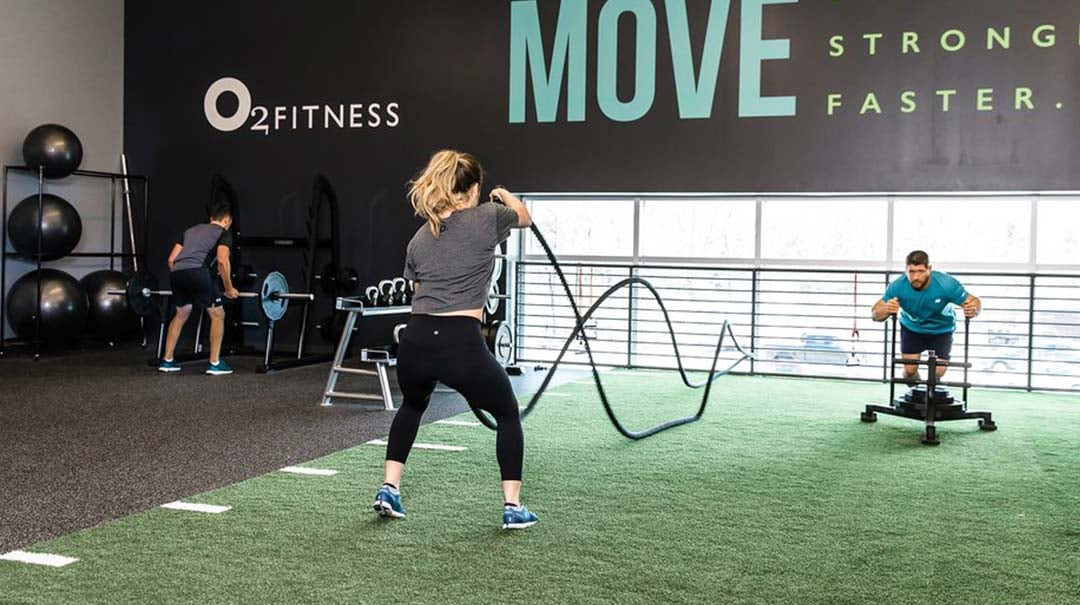How to Disinfect Indoor Artificial Turf
In this post:
- How to kill bacteria on artificial grass
- Why do you need to disinfect artificial turf
- Our recommended solutions to disinfect indoor turf
 Indoor turf is a floor solution for fitness centers and home gyms with lots of advantages; it's engineered to withstand rigorous training and heavy foot traffic; plus its vibrant, lush green color is aesthetically pleasing, adding energy and positivity to training centers. Add to that, indoor turf is highly customizable and versatile in its design, plus it is fairly low maintenance, though it does require some upkeep, and due to usage of the turf in fitness settings where sweat and germs congregate, regular disinfection. We'll take a look at both requirements.
Indoor turf is a floor solution for fitness centers and home gyms with lots of advantages; it's engineered to withstand rigorous training and heavy foot traffic; plus its vibrant, lush green color is aesthetically pleasing, adding energy and positivity to training centers. Add to that, indoor turf is highly customizable and versatile in its design, plus it is fairly low maintenance, though it does require some upkeep, and due to usage of the turf in fitness settings where sweat and germs congregate, regular disinfection. We'll take a look at both requirements.
Everyday Maintenance for Indoor Turf
When you add turf to your facility, you will want to instill 2 types of cleaning protocols: everyday maintenance and scheduled deep cleaning. Indoor turf requires regular upkeep to stay in tip-top shape and keep your members safe. Think of how much sweat and grime the surface is exposed to every day. Turf is likely to collect bacteria if it isn’t regularly cleaned.

Your everyday indoor turf maintenance should look like this:
Step 1: Remove debris. Sweep (or use a flexible non-metal rake) to pick up large bits of debris. Vacuum like you would carpeting to pick up surface soil.
Step 2: Brush any flattened grass areas against the grain to push the bristles back up.
Step 3: Spot clean any stains or messes.

Deep Cleaning and Disinfecting Indoor Turf

When it comes to deep cleaning and disinfecting artificial turf, the best approach is to first make sure you've completed your everyday maintenance.
Once you've finished with everyday maintenance and cleaning of your turf, it's then wise to follow up with tools specifically designed to disinfect—and reach those areas of the turf that can hold on to and harbor bacteria and germs (not to mention mold, mildew, foul smelling odors, viruses, microbes and more). Our top choice for disinfecting tools for indoor turf? Protexus Cordless Electrostatic Sprayers (either the larger-capacity backpack or convenient handheld model), as they are second to none for efficiency, speed, and touch-free disinfection.
Paired with the right sprayer-compatible disinfectant, Protexus is the best way to treat your training turf and disinfect the surface for safe usage by gym members, athletes, & staff. It's important to note that some sprayer-compatible disinfectants can break down the glue that holds the fibers to the backing and may void their warranty. We recommend Vital Oxide to disinfect synthetic turf, as the formula is gentle yet effective.
Your indoor turf deep clean and disinfection should look like this:
Step 1: Remove debris. Sweep (or flexible non-metal rake) to pick up large bits of debris. Vacuum like you would carpeting to pick up surface soil.
Step 2: Brush any flattened grass areas against the grain to push the bristles back up.
Step 3: Spot clean any stains or messes.
Step 4: Apply a surface disinfectant to the turf using an electrostatic sprayer. We recommend the Protexus electrostatic sprayer and Vital Oxide disinfectant.
Step 5: Inspect the surface for any uneven areas or seams. Uneven distribution of the infill is potentially dangerous to users because it can cause them to trip.
Creating and maintaining an ongoing schedule of indoor turf maintenance will allow your facility to enjoy years of use of the flooring surface. By following the steps outlined above, your indoor turf will remain fresh and ready for members and guests to enjoy.
Related content:
Improve your cleaning efficiency and disinfect your turf flooring effectively with Protexus Electrostatic Sprayers. Shop today!
Topics from this blog: #trending
Back


